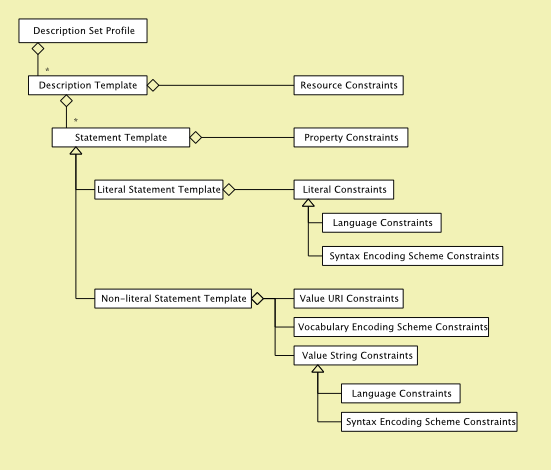-
Notifications
You must be signed in to change notification settings - Fork 12
Related Projects
On this page:
- Dublin Core AP
- RDF AP Requirements
- BIBFRAME
- RDA profiles
- ContentDM
- Digital Public Library of America (DPLA)
- YAMA
- W3C DCAT Profiles
- CEDAR Metadata
- Readings
Dublin Core Application Profiles were based on the Dublin Core Abstract Model and the Singapore Framework.
The general model of application profiles was described in the Singapore framework. This modeled the building blocks of a profile with an aim to maximize reusability.

One implementation step was the creation of a constraint languaged, the Description Set Profile (DSP), that contained the detailed, and potentially machine-actionable, description of the "things" the profile would describe and the terms used to describe them.
A Dublin Core project developed RDF AP Requirements for an application profile with an emphasis on RDF as the base model. There are specific lists for requirements for classes, properties and values, as well as some general requirements.
The BIBFRAME project has developed two online profile editors. These allow you to modify existing profiles or to create a profile "from scratch." To some extent they favor the creation of profiles of the BIBFRAME vocabulary, but might be usable for other profiles as well.
ContentDM is an OCLC metadata creation product that uses a single-resource model. This means that there are no separate entities, just a single entity that is described by the metadata. It primarily uses Dublin Core terms. Here are some links to documentation for some projects using ContentDM:
- University of Washington
- Utah State University
- Hamilton Library - comparing ContentDM, DC Terms, MARC
- Webjunction - best practices for sharing
Metadata Application Profile - PDF
"Yet Another Metadata Application Profile" (YAMA) is a YAML-based "preprocessor to create standard metadata application profile formats". It relies on versioning to allow appropriate processing of profiles and validation of profiles. It makes use of concepts introduced in the Dublin Core Application Profiles: descriptions and statements.
"Our approach centers on the use of metadata templates, which define the data elements needed to describe particular types of biomedical experiments. The templates include controlled terms and synonyms for specific data elements. CEDAR uses a library of such templates to help scientists submit annotated datasets to appropriate online data repositories."
The Workbench has an interface for the creation of metadata. While not specifically about profiles, this could be used for the creation of profiles. What we are calling entities or descriptions they call "elements" and statements are "fields".
- Warwick Framework, 1996
